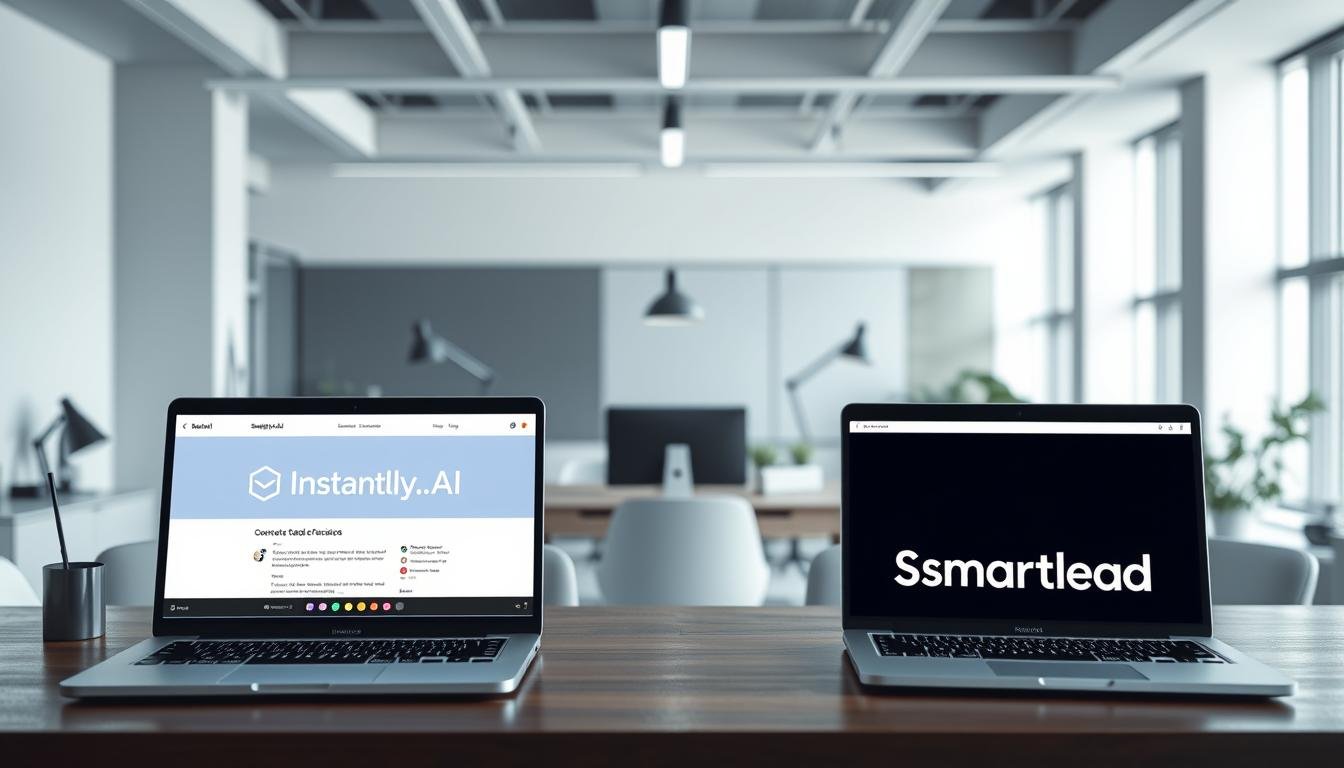Remember the excitement of getting your first few subscribers? That feeling quickly turns to stress as your list grows. You find yourself copying and pasting addresses, worrying about spam folders, and spending hours on tasks that should be simple.
You know your audience deserves better than a messy CC line. You need a system that feels professional and works automatically as you sleep. This is where the right tools make all the difference.
We tested over 30 platforms to find the top solutions for you. The data is clear: choosing the correct service is one of the smartest investments you can make. For every dollar spent, the average return is an incredible $36.
This guide cuts through the noise. We provide tested rankings based on real-world performance, features, and pricing. You will find clear recommendations whether you are just starting out or managing a large ecommerce store.
Key Takeaways
- Email marketing offers an exceptional return on investment, averaging 3500%.
- Professional platforms solve common problems like spam folder delivery and manual subscriber management.
- This guide is based on extensive testing of over 30 different services.
- Recommendations are tailored for different business sizes and needs.
- Free plans are available from many providers with varying subscriber and email limits.
- Key evaluation criteria include automation, deliverability, ease of use, and scalability.
- This article serves as a central hub for detailed information on specific platforms and strategies.
Introduction to Email Marketing Trends in 2025
Digital outreach strategies are evolving at an unprecedented pace, with new technologies reshaping how businesses connect with audiences. The coming year represents a pivotal moment for customer communication channels.
Email ROI and Market Potential
Your investment in customer communication delivers exceptional returns. For every dollar spent, campaigns generate approximately $36 in revenue. This 3500% return makes it one of the most profitable channels available.
The market continues expanding as consumers prefer direct channels over social media. Algorithm changes on other platforms can limit your reach overnight. Your subscriber list becomes your most valuable business asset.
| Feature | Traditional Approach | Modern 2025 Approach |
|---|---|---|
| Personalization | Basic name insertion | AI-driven content tailoring |
| Automation | Simple autoresponders | Behavior-triggered workflows |
| Analytics | Basic open/click rates | Predictive performance insights |
Why 2025 is a Game Changer
Artificial intelligence has become deeply integrated into platforms. This enables unprecedented accuracy in predicting customer behavior. You can generate content and optimize timing automatically.
Sophisticated workflow builders now trigger campaigns based on website activity. Purchase history and engagement patterns drive personalized communication. These tools were previously available only to large enterprises.
This introduction connects to deeper content exploring specific developments. You’ll discover implementation strategies for AI and compliance with privacy regulations. Interactive design and multichannel orchestration are also covered.
Understanding the Pillar and Cluster Content Strategy
The way information is structured can significantly impact your ability to find relevant guidance efficiently. This comprehensive guide serves as your central pillar resource for selecting communication platforms.
You are reading the main hub that connects to numerous detailed cluster articles. These focused pieces explore specific topics in greater depth than possible here.
The strategic interlinking between this pillar page and cluster content serves multiple purposes. It helps you locate exact information without overwhelming details. This approach improves your learning journey with logical next steps.
You will notice internal links directing you to related cluster content throughout this article. Those specialized articles link back here, creating an authoritative content hub. This establishes the site as your go-to source for guidance.
This organization method benefits you by arranging extensive information into a logical hierarchy. You start broad with this overview, then drill down into areas relevant to your needs. Your decision-making improves dramatically with both comparative overview and detailed analysis.
Key Features to Look For in Email Marketing Software
Modern communication platforms offer diverse features that can transform how you interact with subscribers. The right tools empower you to create compelling campaigns without technical expertise.
Drag-and-Drop Editors and Custom Templates
Visual editors let you design professional layouts by dragging elements into place. This eliminates the need for coding knowledge while maintaining design flexibility.
Template libraries vary significantly between providers. Starting with pre-designed layouts saves valuable time and ensures visual consistency across your campaigns.
| Platform Feature | Basic Option | Advanced Solution |
|---|---|---|
| Template Selection | 40+ standard designs | 600+ customizable options |
| Editor Integration | Basic drag-and-drop | Smart design automation |
| Mobile Testing | Simple preview | Multi-device simulation |
Automation and Personalization Capabilities
Sophisticated automation goes beyond simple autoresponders. Look for visual workflow builders that trigger campaigns based on subscriber behavior.
“Personalization transforms generic messages into relevant conversations that drive engagement.”
Dynamic content blocks adapt based on subscriber segments and browsing history. These features ensure your messages resonate at the right moment in the customer journey.
For deeper guidance on evaluating specific functionalities, explore our cluster content covering detailed feature analysis and implementation strategies.
Performance Metrics and Analytics for Email Campaigns
Understanding your analytics transforms guesswork into data-driven decision making. The right metrics reveal what works and what needs improvement in your outreach strategy.
Tracking key performance indicators helps you optimize every aspect of your communication. You gain valuable insights into audience behavior and campaign effectiveness.
Delivery, Open, and Click-Through Rates
Your delivery rate is the foundation of successful outreach. Emails must reach inboxes to generate results. Quality platforms maintain high deliverability through proper authentication.
Open rates show how compelling your subject lines appear to recipients. This metric helps you test different approaches for maximum engagement.
Click-through rates measure whether your content motivates action. They evaluate content relevance and call-to-action effectiveness beyond simple opens.
Measuring ROI Effectively
Return on investment tracking connects campaigns to revenue generation. You need to monitor conversions from sales, bookings, or other monetization methods.
Advanced analytics provide deeper insights into subscriber behavior. Heat maps show exactly where people click within your messages.
For detailed guidance on interpreting these metrics, explore our cluster content covering analytics interpretation and improvement strategies.
User Experience and Interface Review
The interface you interact with daily can make or break your marketing efficiency. Complicated platforms slow down campaign creation and frustrate your team. Intuitive tools let you focus on strategy rather than struggling with software.
Ease of Use and Setup Speed
Your setup time matters when you’re eager to launch campaigns quickly. Some platforms require just minutes for domain verification. Others may have lengthy onboarding processes that delay your first send.
Mailtrap demonstrates excellent efficiency with 5-minute verification. You can create campaigns within 15 minutes. This rapid deployment gets your communication flowing faster.
Design and Mobile Responsiveness
Dashboard design influences your daily workflow efficiency. Clean interfaces like Brevo’s keep everything logically organized. Cluttered layouts force you to hunt through menus for basic tasks.
You need tools that ensure proper display across devices. Real-time preview modes show how campaigns appear on smartphones. Over half of all emails are opened on mobile devices.
Customization options like GetResponse’s widgets let you configure your workspace. Display frequently used metrics and tools right at your fingertips. This personalization enhances your daily workflow.
During free trials, test how quickly you complete common tasks. Time efficiency compounds over hundreds of campaigns annually. For detailed guidance, explore our free email marketing services with video tutorials.
Security and Compliance Standards
Navigating legal requirements becomes crucial as your subscriber list grows internationally. Modern platforms include essential tools to help you meet these obligations seamlessly.
Your European contacts fall under GDPR protection. This requires explicit consent for communications and transparent data usage explanations.
Data Protection and GDPR Compliance
Quality services provide built-in consent management systems. They track how and when each contact agreed to receive your messages.
Data processing agreements outline provider responsibilities for information protection. Reputable companies offer these documents for legal coverage.
You need tools that honor data subject requests efficiently. Subscribers should access or delete their information easily.
CAN-SPAM Act Considerations
United States regulations govern your outreach efforts. They require accurate header information and non-deceptive subject lines.
Automatic unsubscribe links appear in every message you send. Platforms ensure opt-out requests get honored within 10 business days.
Your physical postal address must appear clearly in advertisements. These features protect you from costly violations.
Strong encryption standards safeguard subscriber information during transmission and storage. TLS and AES 256 encryption prevent unauthorized access.
For detailed implementation checklists, explore our compliance requirements guide. It provides step-by-step procedures for different regulations.
- Double opt-in confirmation ensures valid consent
- Regular security audits demonstrate commitment to protection
- Clear communication about what subscribers receive builds trust
- Never purchase contact lists – grow organically
Pricing Models and Free Plans Overview
The financial aspect of choosing a platform requires careful evaluation of both immediate and long-term costs. Free options provide excellent starting points, but understanding their limitations prevents unexpected upgrade requirements.
Comparing Value: Free vs. Paid Plans
Free plan generosity varies dramatically across providers. Some offer unlimited emails with thousands of contacts, while others restrict monthly sending volumes significantly.
Your evaluation should focus on feature restrictions. Certain platforms include automation even on free tiers, while others reserve advanced tools for paying customers.
| Platform | Free Subscribers | Monthly Emails | Starting Paid Price |
|---|---|---|---|
| Kit | 10,000 | Unlimited | Varies |
| Brevo | 100,000 | 9,000 | $9/month |
| Mailchimp | 500 | 1,000 | $13/month |
| MailerLite | 500 | 12,000 | $9/month |
Scaling Your Investment as You Grow
Calculate your cost per contact across different platforms. Pricing structures vary significantly – some charge based on subscriber count while others focus on email volume.
Your long-term investment scales more affordably with gradual pricing tiers. Providers like Moosend offer competitive rates as you grow from hundreds to thousands of contacts.
For detailed pricing comparisons, explore our cluster content analyzing total cost of ownership for different business sizes.
Integrations with Other Marketing Tools
Isolated platforms create data silos, but integrated systems create unified customer experiences that drive growth. Your communication effectiveness multiplies when tools work together seamlessly.
Connectivity transforms individual applications into powerful ecosystems. This eliminates manual data transfers and ensures consistent information flow.
CRM and E-commerce Integrations
Your customer relationship management system should sync automatically with your communication platform. This ensures campaigns leverage current subscriber behavior and purchase history.
E-commerce integrations become essential for automating transactional messages. Platforms like Omnisend offer pre-built connections to major systems like Shopify and WooCommerce.
Real-time product catalog synchronization enables personalized recommendations. Abandoned cart campaigns trigger automatically based on user activity.
Utilizing APIs and Third-Party Connections
Zapier integration expands your platform’s connectivity exponentially. It bridges thousands of applications even without native integrations.
API access enables custom connections for unique business needs. Robust documentation helps development teams build precise workflows.
Integration depth matters more than mere availability. Deep connections sync behavioral data and trigger sophisticated automation.
For detailed implementation guidance, explore our integration tutorials and compatibility matrices covering various platforms.
Advanced Automation and AI Features
The most powerful platforms connect subscriber behavior directly to automated messaging. This transforms your outreach from scheduled broadcasts into responsive conversations.

Sophisticated automation uses various triggers to start personalized sequences. Your workflows can react to specific actions subscribers take.
Automated Workflows and Triggers
You build journeys that guide contacts based on their interests. Platforms offer hundreds of pre-built templates to accelerate setup.
Your marketing automation should respond to different trigger types:
- Time-based: Sending a welcome series three days after signup.
- Behavior-based: Triggering a cart recovery sequence after a site visit.
- Engagement-based: Sending related content after a link click.
Conditional logic creates branching paths within your automations. This ensures each person receives relevant content for their situation.
Implementing AI for Content and Segmentation
Artificial intelligence enhances your efforts significantly. It can generate compelling subject lines and optimize send times for each individual.
AI tools analyze data patterns humans might miss. They can predict which subscribers are most likely to convert or churn.
For step-by-step guidance, explore our cluster content with workflow templates and AI implementation guides. These resources help you build sophisticated systems.
Customization and Flexibility in Email Campaigns
Your brand’s visual identity should shine through every communication you send to subscribers. Flexible design tools let you create campaigns that reflect your unique style.
Tailoring Templates to Your Brand
Template libraries vary significantly across platforms. AWeber offers over 600 customizable options, while ActiveCampaign provides 240+ designs. Brevo includes 40+ templates for different campaign types.
AWeber’s Smart Designer analyzes your website to generate branded layouts automatically. This feature creates custom templates in minutes without design skills.
| Platform | Template Quantity | Customization Features |
|---|---|---|
| AWeber | 600+ | Smart Designer, HTML editing |
| ActiveCampaign | 240+ | Drag-and-drop editor, brand kits |
| Brevo | 40+ | Mobile-responsive designs |
Responsive and Adaptive Design Options
Your emails must display perfectly across all devices. Adaptive templates automatically adjust layouts based on screen size. Preview modes show how campaigns appear on smartphones and tablets.
“Consistent design builds trust and recognition with your audience over time.”
Dynamic content blocks personalize product recommendations based on subscriber behavior. This creates relevant shopping experiences without manual campaign versions.
For detailed guidance, explore our template customization tutorials covering brand consistency techniques.
Scalability and Growth Opportunities
Growth potential separates basic tools from powerful communication platforms. Your chosen service should expand alongside your audience without limitations.
Built-in lead generation tools capture subscribers across multiple touchpoints. Look for landing page builders and various form types like popups and embedded forms.
Strategies for Growing Your Contact List
Unique features accelerate your expansion. Some platforms offer referral programs that turn subscribers into active growth partners. Cross-promotion networks connect you with related publications.
Quality matters more than quantity when building your audience. Focus on attracting genuinely interested people through valuable incentives. This approach maintains high engagement rates.
| Platform Feature | Basic Growth Tools | Advanced Expansion Features |
|---|---|---|
| Form Types | Embedded signup forms | Popup, slide-in, exit-intent forms |
| Landing Pages | Basic template selection | Customizable, A/B testable designs |
| Referral Systems | Manual sharing links | Automated reward programs |
Scalability ensures your platform grows from hundreds to millions of contacts. Verify that pricing remains reasonable at higher tiers. This prevents disruptive migrations as your business expands.
For detailed implementation guidance, explore our cluster content covering list building strategies and growth tactics. These resources help you maximize your audience development.
Customer Support and Educational Resources
Access to knowledgeable support becomes your lifeline when facing unexpected technical obstacles. The quality of assistance available separates exceptional platforms from merely adequate ones.

Different providers offer dramatically varied support experiences. Some like Mailtrap provide 24/7 human assistance regardless of your plan. Others limit help during critical periods.
Your learning journey benefits from comprehensive educational materials. These resources help you master features without waiting for responses.
Tutorials, Webinars, and Knowledge Base
Searchable knowledge bases answer common questions instantly. Video tutorials demonstrate complex features step by step. Webinars teach strategy beyond basic platform use.
Brevo offers free e-books covering automation best practices. Certification programs validate your expertise. These materials shorten your learning curve significantly.
For detailed guidance, explore our tutorial libraries and getting-started guides covering implementation strategies.
Live Chat and Community Forums
Immediate assistance through live chat resolves urgent issues quickly. GetResponse offers 24/7 chat support on paid plans. This helps users operating across time zones.
Community forums create peer-to-peer support networks. Users share solutions and discuss strategies. Active communities provide diverse perspectives on problem-solving.
Phone support remains valuable for complex issues. AWeber includes this personal touch even on free plans. Testing support during trials reveals true responsiveness.
Interlinking Strategy for Pillar and Cluster Content
Building a network of interconnected articles creates a powerful learning ecosystem for your needs. This comprehensive guide serves as your central hub, connecting to specialized resources through strategic links.
Building Your Internal Linking Network
You experience this strategy in action while reading. Contextual links guide you to deeper content at relevant moments. When topics spark your interest, you can immediately explore specialized articles.
This hub-and-spoke architecture serves dual purposes. It enhances your navigation experience with logical pathways. Search engines also recognize the comprehensive coverage and topical authority.
The interconnected resources distribute authority throughout the content network. This improves visibility for all related articles. Your decision-making process becomes more efficient with both broad overviews and detailed analysis.
Bookmark this guide as your starting point. It connects you to dozens of specialized resources covering implementation tutorials and industry applications. Together, they form a complete educational system for your success.
What Makes the Best Email Marketing Software 2025 Stand Out?
The standout platforms in today’s market don’t just offer features—they solve specific problems with unique innovations. You need tools that address your particular business challenges rather than providing generic solutions.
Some platforms focus on monetization for content creators. Others excel in ecommerce automation or provide exceptional scalability. The right choice depends on your specific goals and audience needs.
Unique Selling Points and Innovative Features
Your evaluation should consider how each product solves real-world challenges. Look beyond basic functionality to find specialized capabilities that match your operation.
Sophisticated automation separates advanced platforms from basic ones. Some systems offer hundreds of pre-built workflow templates with complex conditional logic. This enables sophisticated customer journeys without enterprise pricing.
| Platform | Specialization | Standout Feature |
|---|---|---|
| Kit | Creator Monetization | Digital product sales integration |
| Omnisend | Ecommerce | 350+ product-focused templates |
| ActiveCampaign | Automation | 900+ workflow templates |
| Brevo | Scalability | High contact limits on entry plans |
Design efficiency improves with smart features like automated template generation. Some platforms analyze your website to create branded layouts instantly. This saves time while maintaining visual consistency.
For detailed comparisons of these innovative capabilities, explore our cluster content reviewing specific marketing platforms and their unique advantages.
Case Studies and Real-World Success Stories
Success stories from various industries reveal patterns that can inform your approach. Real examples show how different businesses achieve remarkable results with strategic communication.
User testimonials highlight specific platform strengths. Mailtrap receives praise for deliverability, while Brevo’s free plan helps startups launch without upfront costs.
Examples from Small Businesses
Solopreneurs often begin with generous free plans. One consultant started sending 300 daily messages to build their practice. They upgraded only when revenue justified the expense.
Content creators use specialized tools for newsletters. These platforms help build audiences and monetize through subscriptions. Referral programs accelerate growth beyond traditional methods.
Insights from Larger Enterprises
Major companies implement complex customer journeys across multiple touchpoints. They use lead scoring systems and integrated CRMs for alignment.
Sophisticated automation workflows generate significant revenue from subscribers. These systems recover abandoned carts and send personalized product recommendations.
| Success Factor | Small Business Focus | Enterprise Priority |
|---|---|---|
| Platform Selection | Free plan generosity | Advanced automation |
| Key Metrics | Subscriber growth rate | Customer lifetime value |
| Automation Use | Welcome sequences | Multi-channel journeys |
| Integration Needs | Basic e-commerce | Full CRM alignment |

These examples demonstrate how proper execution translates to business outcomes. You can find detailed case studies in our cluster content featuring industry-specific success stories.
Explore how SaaS companies nurture trials and ecommerce brands drive repeat purchases. Service businesses fill appointment calendars through strategic campaigns.
Conclusion
The extensive analysis presented here provides you with a clear roadmap for choosing your communication tool. You now understand how different platforms serve various business needs, from content creators to large enterprises.
Your next step involves testing the free plans or trials that match your primary use case. Experience the interface firsthand before committing to any subscription. This hands-on approach ensures the platform fits your workflow.
The exceptional 3500% ROI makes this investment highly worthwhile. Your subscriber list represents a valuable asset that deserves the right tools.
Explore our detailed cluster content for implementation guides and specific platform tutorials. You’re now equipped to make a confident decision that will serve your business for years to come.
FAQ
What are the most important features to consider when choosing a platform?
You should prioritize a user-friendly drag-and-drop editor, robust automation tools, and strong analytics. Look for capabilities that allow for personalization and seamless integration with your other tools, like your CRM or e-commerce store. These features are foundational for an effective strategy.
How can I effectively measure the return on investment for my campaigns?
Track key performance indicators like your delivery, open, and click-through rates. More importantly, monitor conversions and revenue generated directly from your efforts. Many platforms offer built-in analytics dashboards that help you connect your activities to sales, giving you a clear picture of your ROI.
Are free plans from these platforms sufficient for a small business?
A free plan can be an excellent starting point, allowing you to build a small contact list and test basic features. However, as your business grows, you will likely need the advanced automation, segmentation, and higher sending limits offered by paid plans to scale your efforts effectively.
What security and compliance standards should I be aware of?
It’s crucial to choose a tool that adheres to regulations like the GDPR and the CAN-SPAM Act. This includes features for managing subscriber consent, providing easy unsubscribe options, and protecting customer data. Using a compliant platform helps you build trust and avoid legal issues.
How important are integrations with other tools?
Integrations are vital for a streamlined workflow. Connecting your platform to your customer relationship management system, e-commerce store, or other third-party applications via API allows for automated data syncs. This creates a more personalized experience for your audience and saves you significant time.
Can I customize the templates to match my brand’s look and feel?
A> Yes, most modern tools offer highly customizable templates with drag-and-drop editors. You can typically adjust colors, fonts, and layouts, and even add your own logo and images. This ensures every message you send is consistent with your brand identity and looks professional on any device.




